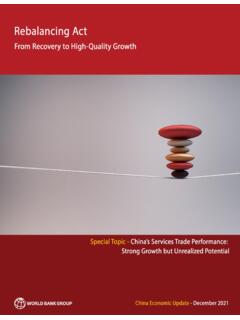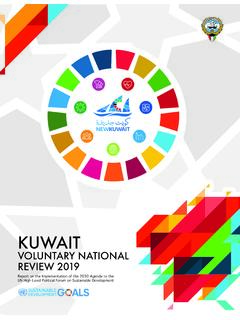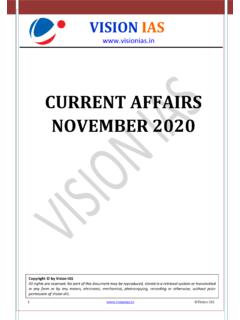Transcription of Improving Plastics Management: Trends, policy responses ...
1 Improving Plastics Management: Trends, policy responses , and the role of international co-operation and trade policy PERSPECTIVES. OECD ENVIRONMENT policy PAPER NO. 12. OECD . 3. This policy Paper comprises the Background Report prepared by the OECD for the G7 Environment, Energy and Oceans Ministers. It provides an overview of current Plastics production and use, the environmental impacts that this is generating and identifies the reasons for currently low Plastics recycling rates, as well as what can be done about it. Disclaimers This paper is published under the responsibility of the Secretary-General of the OECD. The opinions expressed and the arguments employed herein do not necessarily reflect the official views of OECD member countries. This document and any map included herein are without prejudice to the status of or sovereignty over any territory, to the delimitation of international frontiers and boundaries and to the name of any territory, city or area.
2 For Israel, change is measured between 1997-99 and 2009-11. The statistical data for Israel are supplied by and under the responsibility of the relevant Israeli authorities. The use of such data by the OECD is without prejudice to the status of the Golan Heights, East Jerusalem and Israeli settlements in the West Bank under the terms of international law. Copyright You can copy, download or print OECD content for your own use, and you can include excerpts from OECD. publications, databases and multimedia products in your own documents, presentations, blogs, websites and teaching materials, provided that suitable acknowledgment of OECD as source and copyright owner is given. All requests for public or commercial use and translation rights should be submitted to Requests for permission to photocopy portions of this material for public or commercial use shall be addressed directly to the Copyright Clearance Center (CCC) at or the Centre fran ais d'exploitation du droit de copie (CFC) at Image credits: ImagineStock Shutterstock (cover); Menzl Guenter / Shutterstock (p.)
3 B). OECD 2018. ISSN 2309-7841. Authorised for publication by Rodolfo Lacy, Director, Environment Directorate Improving Plastics Management: Trends, policy responses , and the role of international co-operation and trade Background Report Prepared by the OECD for the G7. Environment, Energy and Oceans Ministers September 2018. Organisation for Economic Co-operation and Development 2. 1. Plastics : Production, uses, and benefits to society 1. Plastics are a remarkable family of materials that have gathered attention recently due to their ubiquity in the global economy, the low material recovery rates that they currently achieve, and the environmental impacts associated with current disposal methods. 2. Although early forms of Plastics were already in existence during the mid-19th century, Plastics other than Bakelite were largely unknown prior to 1950. Since then, Plastics have rapidly become one of the most commonplace materials on the planet. In 2015, global Plastics production reached 407 million tonnes per annum (Mtpa) (Figure 1), making it more than the production of paper (400 Mtpa), fish (200 Mtpa), and aluminium (57 Mtpa) 1,2,3.
4 If production continues to grow at similar rates, Plastics production will reach 1 600 Mtpa in 2050 4. 3. The rapid growth of Plastics production and use is largely due to the unique properties of the material. Plastics have a high strength-to-weight ratio, can be easily shaped into a wide variety of forms, are impermeable to liquids, and are highly resistant to physical and chemical degradation. Plastics can also be produced at relatively low cost. It is these properties that have led to the substitution of traditional materials ( concrete, glass, metals, wood, natural fibres, and paper) by Plastics in many applications. Figure 1. Global Plastics production: 1950 to 2015. Source: Geyer, R., J. Jambeck and K. Law (2017), Production, use, and fate of all Plastics ever made , Science Advances, Vol. 3/7, p. e1700782, 4. Plastics are a diverse set of materials with specific chemical and physical properties. At least eight major polymer types are widely used 5, and a range of chemical additives are introduced at the manufacturing stage in order to improve polymer performance.
5 The diversity of Plastics has important implications for their end of life management. In BACKGROUND REPORT: Improving Plastics MANAGEMENT OECD 2018. Organisation for Economic Co-operation and Development 3. particular, it means that the issues that hinder material collection, sorting, and recovery can differ substantially across polymers. 5. The versatility of Plastics has led to their use in almost all major product categories (Figure 2). Plastics packaging is the largest application by weight, but Plastics are also used widely in the textile, consumer goods, transport, and construction sectors. Some polymers of plastic are used primarily in a single application ( polyethylene in packaging) while others are used more widely ( polypropylene). This distinction also has implications for end-of-life Plastics management: developing effective sorting and recycling technologies is likely to be simpler for polymers used in a narrower range of applications. Figure 2.
6 Global Plastics use by polymer and sector LDPE, LLPDE PET HDPE PP PS PVC PUR PPA Other 150. Annual waste generation (million 100. tonnes). 50. 0. Note: The polymer breakdown for each product category has been translated on a proportional basis from 2015. production data. Polyester, polyamide, and acrylic (PPA) fibres are assigned exclusively to the textiles sector following Geyer, Jambeck, and Law (2017[1]). Source: Geyer, R., J. Jambeck and K. Law (2017), Production, use, and fate of all Plastics ever made , Science Advances, Vol. 3/7, p. e1700782, 6. The widespread use of Plastics has generated a number of benefits for society and for the environment. Plastics are often used to protect or preserve foodstuffs and, in doing so, help to reduce food waste. Plastics are also an important input in vehicles, where their relatively light weight results in lower fuel use and greenhouse gas emissions. Plastics are widely used in infrastructure applications, where their impermeability and durability can lead to water savings in urban areas.
7 Finally, the use of Plastics rather than materials derived from biomass ( wood and paper) in a range of applications could slow land-cover change and biodiversity loss 6. 2. The environmental side effects of Plastics production and use 7. The increasing pervasiveness of Plastics has not been without drawbacks. The production and disposal of Plastics is responsible for significant greenhouse gas emissions and, when poorly managed, generates Plastics pollution in the natural environment. In BACKGROUND REPORT: Improving Plastics MANAGEMENT OECD 2018. Organisation for Economic Co-operation and Development 4. addition, the loss of natural resources resulting from current systems of waste management represents a missed economic opportunity. For example, it is estimated that 95% of the material value of used plastic packaging, or USD 80 - 120 billion, is lost annually. 7. Greenhouse gas emissions 8. Traditional Plastics production involves the transformation of petroleum or natural gas into their constituent monomers.
8 This process is highly energy-intensive, and was estimated to account for 400 million tonnes of greenhouse gas emissions (around 1% of the global total) in 2012 8. 9. The fossil fuel feedstock used in Plastics production also accounts for 4 - 8% of global oil and gas production 9,10 and this share could increase further in the future 11. The hydrocarbon molecules that are bound into the structure of Plastics are initially inert, but release carbon dioxide as well as other greenhouse gases when incinerated. Plastics pollution 10. The proliferation of Plastics use, in combination with poor end-of-life waste management, has resulted in widespread, persistent Plastics pollution. Around 6 300. million tonnes of Plastics waste are thought to have been generated between 1950 and 2015, of which only 9% were recycled, and 12% incinerated, leaving nearly 80% to accumulate in landfills or the natural environment 12. Plastic pollution is present in all the world's major ocean basins, including remote islands, the poles and the deep seas, and an additional 5 to 13 million tonnes are introduced every year 13,14.
9 11. Modelling suggests that around 10% of global Plastics waste generation (or 30 Mt). was mismanaged in 2010 15,16. G7 countries are thought to account for less than 2% of this material: around half originates in ten large emerging economies (Figure 3). This highlights the importance of Improving waste collection services in middle- and low-income countries. BACKGROUND REPORT: Improving Plastics MANAGEMENT OECD 2018. Organisation for Economic Co-operation and Development 5. Figure 3. Mismanaged Plastics waste by country in 2010. China Indonesia Philippines Vietnam Sri Lanka Thailand Egypt Malaysia Nigeria Bangladesh Other Source: Jambeck, J. et al. (2015), Marine pollution. Plastic waste inputs from land into the ocean. , Science (New York, ), Vol. 347/6223, pp. 768-71, 12. Once in the ocean, Plastics have a number of significant economic impacts. Marine wildlife is harmed through ingestion of Plastics or entanglement, with negative implications for ecosystem health and the overall sustainability of fisheries 17.
10 Coastal tourism is also affected as tourists seek to avoid beaches known to have high concentrations of Plastics litter. Taken together, the economic cost of these impacts has been estimated at USD 13. billion per year 18. 13. Plastics pollution also poses risks for human health. The presence of plastic in seafood, including fish and shellfish, and their subsequent consumption by the public has led to concerns about chemical bio-accumulation in the food chain, although empirical evidence for this is currently limited19,20,21. Plastics are also entering the food chain more directly. Research has found microplastic contamination in tap water and bottled water across a number of countries 22,23, and plastic contamination has also been found in sea salts 24. 14. Plastics pollution warrants considerable attention for two additional reasons. The first relates to the longevity of Plastics : those that accumulate in the natural environment will only decompose over hundreds, or even thousands of years, during which time they fragment into smaller microplastics and nanoplastics.

















